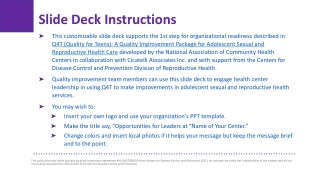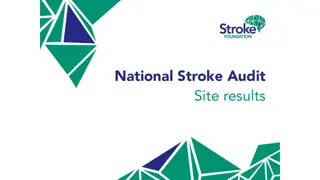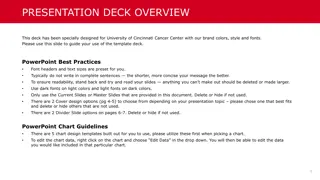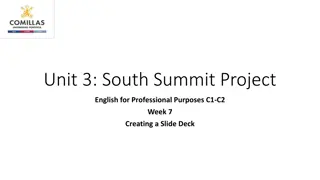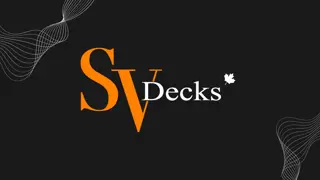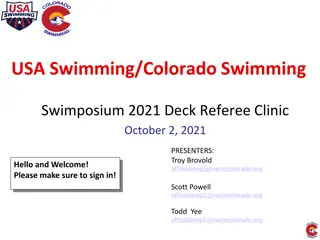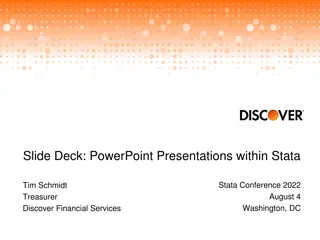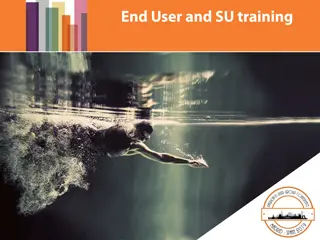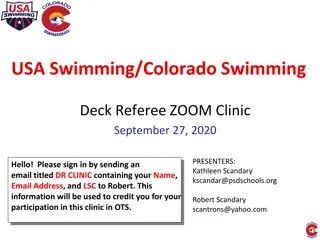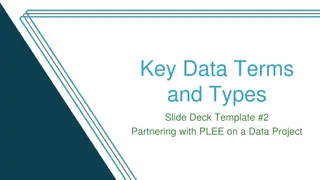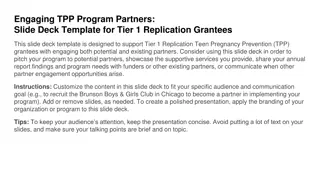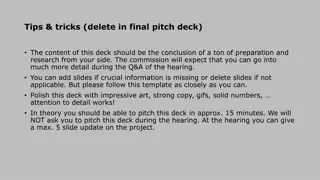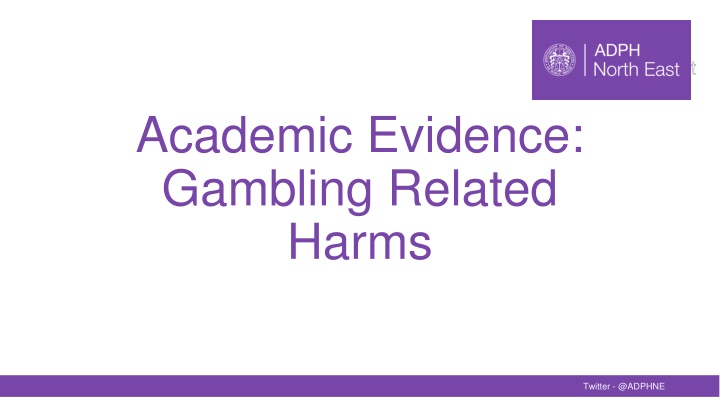
Gambling-Related Harms: Academic Insights and Guidance
Explore academic evidence on gambling-related harms including mental health, financial impacts, stigma, and more. Discover literature, interventions, and guidance while being mindful of potential conflicts of interest within the gambling industry.
Download Presentation

Please find below an Image/Link to download the presentation.
The content on the website is provided AS IS for your information and personal use only. It may not be sold, licensed, or shared on other websites without obtaining consent from the author. If you encounter any issues during the download, it is possible that the publisher has removed the file from their server.
You are allowed to download the files provided on this website for personal or commercial use, subject to the condition that they are used lawfully. All files are the property of their respective owners.
The content on the website is provided AS IS for your information and personal use only. It may not be sold, licensed, or shared on other websites without obtaining consent from the author.
E N D
Presentation Transcript
Academic Evidence: Gambling Related Harms Twitter - @ADPHNE
Introduction The purpose of these slides are to provide relevant and up to date literature to aid public health colleagues in evidencing gambling related harms as a public health concern. Please use these slides to support local development of products for gambling harms. If other partners locally may benefit from seeing this resource, please share with them as required. Twitter - @ADPHNE
The Scope of Gambling Related Harms Mental Health and Wellbeing Financial Relationship: Family, Friends and Partners Education and Employment Cultural, Stigma and Ethnicity Crime and anti-social behaviour Literature will be categorised by the following six categories, encompassing a scope of gambling related harms. Twitter - @ADPHNE
The Scope of Gambling Related Harms For the purpose of this slide pack, gambling related harms have been categorised into six themes. For each of the six themes of gambling harms, content is split into four sections: Literature and Prevalence Lived Experience (including affected others) Interventions and Treatment Academic Resources Summary Twitter - @ADPHNE
Guidance on Gambling Harms Literature The gambling industry fund academic research into gambling, which can influence messaging. This resource has attempted to present as much literature that is free from any conflict of interest (COI). COI: If academics accepted money or worked for the gambling industry at the time of the publication. This can also be partnerships or indirect funding or speaking at events. Despite all efforts, in order to provide as much helpful evidence, some papers have COI when: Twitter - @ADPHNE
Guidance on Gambling Harms Literature One or more of the author team has: worked for industry in a research/ consultancy role, is linked to a GRH charity that accepts industry funding or works in a GRH treatment service that accepts funding from the gambling industry. Additionally, some of the international studies referred to will have different laws surrounding gambling compared to the United Kingdom so please note they may not have directly replicable results for creating interventions. Twitter - @ADPHNE
Guidance on Gambling Harms Literature Then when reading the research papers, please be aware of other influencing factors that goes into the design of the publication as this can have a bearing on the final outcomes. This can be the sample size, the demographics of the population and the research question being asked. statistical tests used, the Twitter - @ADPHNE
Hierarchy of Evidence Building on the previous slide, there are a range of academic papers used in the formation of the slide deck. As a guide, the quality of evidence can be graded by using the following image here However, relying solely on policy documents and reviews on GRH s does not factor in the qualitative studies that impact how harm is experienced, described and addressed. Hence, there is a blended collection of academic papers from interviews, frameworks, policy guides and literature reviews to reflect the multifaceted nature of GRH research. prevalence studies, Source: (PDF) Options for basing Dietary Reference Intakes (DRIs) on chronic disease endpoints: report from a joint US-/Canadian- sponsored working group (researchgate.net) Twitter - @ADPHNE
Guidance on Gambling Harms Literature We want to move away from being reliant upon industry funding as laid out by the ADPH NE 2024 position statement However, this will take time and needs to happen gradually across treatment pathways, educational institutions, health services and local councils. Therefore, papers which have some ties to the industry but had no influence over the design, write up or analysis of the results will be included. Twitter - @ADPHNE
Information on the Literature On each slide you will find: Hyperlinks to the academic text Links written in full in the notes sections Full references in order of appearance at the end of the slide deck Twitter - @ADPHNE
Information on the Literature Regarding the international studies, not only is there a difference by nationality there is also a cultural difference. Not all studies can be replicated in another nation due to these cultural differences. It is also important to recognise that the slides are split into specific gambling harms. Please remember when reviewing the literature to not only take the individual perspective but also the wider environmental viewpoint as well. Placing gambling on the same level as other topics such as tobacco, alcohol and fast-food shows it too has a direct impact upon the commercial determinants of health. Finally, the slides have just focused on the academic literature government briefs relating to gambling or gambling related harms. and not reports or Twitter - @ADPHNE
Mental Health and Wellbeing: Literature and Prevalence Mental health is a broad topic within gambling and GRH as it has a wide range of academic literature and sub-topics (Bergamini et al., 2018). This covers areas such as depression (Sagoe et al., 2017) and suicide (Andreeva et al., 2022; Marionneau and Nikkinen, 2022) along with other topics of such as substance misuse (Manning et al., 2017). Mental health does not exist for one age group and can be affected for all age groups from adolescents (Richard and Derevensky, 2017) to adults (Stanmyre et al., 2022). Regarding prevalence rates it is shown in the literature that gambling and mental health appears in the following populations; 1.Canadian sample of 900 patients (with a mental illness) found that 5.3% presented with at-risk gambling (Bergamini et al., 2018). 2.English sample of 1058 patients (general population) found that 0.9% presenting with high levels of problem gambling and 4.3% presented with low-moderate of problem gambling severity (PGSI 1-4) (Cowlishaw et al., 2017) The next slide goes into more detail regarding the lived experience of GRH from the perspective of affected others. Twitter - @ADPHNE
Mental Health and Wellbeing: Lived Experience (including affected others) Lind et al reviewed GRH for affected others within a Finnish population survey (2021) covering 7186 adults aged 18 years and over who participated in the Gambling Harms Survey evaluating year 2016. The proportion of affected non- family members (ANFs) was 8.4%, and 5.6% were affected family members (AFMs). AFMs were usually women, and ANFs were usually men. Emotional, relationship, and financial harms were the most common types of harm. The odds of experiencing financial harm were highest for the 18- to 34-year-olds (OR 1.82) and for those whose partner/ex-partner had a gambling problem (OR 3.91). Having a parent/step-parent (OR 1.93) and child/stepchild (OR 3.64) increased the odds of experiencing emotional harm. Conclusions GRH profiles for AO subgroups varied, which emphasizes the need for effective harm minimization strategies for those in need. Twitter - @ADPHNE
Mental Health and Wellbeing: Interventions and Treatment There are a range of interventions and treatments available to help those with gambling or GRH that are dealing with mental health issues. These treatments and interventions can range from (not an exhaustive list these are just examples) Cognitive Behavioural Therapies (CBT) 2. Motivational Interviewing (MI) 3. Group sessions or Workshops (AA Groups) Self-Help Interventions (Internet resources) 5. Telephone Interventions (with a counsellor) 6. Behavioural Therapy 1. 4. Twitter - @ADPHNE
Mental Health and Wellbeing: Research Article Example Title: Should screening for risk of gambling-related harm be undertaken in health, care and support settings? Blank et al., (2021) Aim: This study aimed to identify interventions to screen for risk of GRH. The criteria were setting, participants, interventions and outcome measures (gambling behaviours, service use). Finding: 3 papers evaluating screening interventions delivered in general practice, mental health service and substance abuse treatment, indicated evidence of potential effectiveness. 6 papers supported the feasibility and acceptability of delivering interventions in various settings. Conclusion: Screening interventions appear feasible and acceptable in a range of community and healthcare settings for those at risk of gambling harm. 05/06/2024 Twitter - @ADPHNE
Mental Health & Wellbeing: Academic Resources Prevalence Topic Target Population Year of Publication Author Journal and Link Sourced Funding or COI from the Gambling Industry? Primary Outcome Findings Bergamini et al Journal of Behavioural Addictions No The study evidenced a higher rate of at-risk gambling > general population. Prevalence of Mental Health Canadian Patients with Severe Mental Illness 2018 English Health Survey Cross Sectional Analysis 2024 Moore et al BMC Public Health No Controlling for comorbidities, study found no associations between severity and HRQoL. Health Related Quality of Life (HRQoL) and Problem Gambling Severity problem gambling 2020 Butler et al Journal of Gambling Studies No Compared to non-problem gamblers, low severity gamblers were moderate/high severity gamblers were 3x as likely, to have low mental wellbeing Problem Gambling Severity & Health Risk Behaviours Isle of Man Representative Sample 2x as likely & 2017 Manning et al Journal of Behavioural Addictions Yes Elevated rates of harmful substance use among moderate-risk and problem gambling suggest overlapping vulnerability to addictive behaviours. Prevalence rates of Gambling among Substance Misuse Population Victoria, Australia patients 2016 Assanangkornchai et al Journal of Behavioural Addictions No The gambling disorders as a public health concern in Thailand and suggests a need for culturally specific preventive measures. study confirms the recognition of Psychiatric Comorbidity, Gambling Type and Gambling Disorders Thailand General Population National Mental Health Survey 2023 Tulloch et al Addictive Behaviours No Living with someone with a gambling problem has health, financial and social impacts. Gambling Problems relate to Health and Wellbeing Australian Households from National Income Survey Twitter - @ADPHNE
Mental Health & Wellbeing: Academic Resources Lived Experience Topic Target Population Year of Publication Author Journal and Link Sourced Funding or COI from the Gambling Industry? Primary Outcome Findings 2022 Marionneau and Nikkinen Frontiers: Psychology Yes Effective prevention is needed by adapting a more comprehensive public population-level interventions. Gambling-related suicides and suicidality: Qualitative Evidence Review Suicidal Behaviour within Gambling Populations health approach & Andreeva et al Addiction Research & Theory No The work shows distinct risk factors among suicide decedents with a history of problem gambling & that this population presents an elevated suicide risk. Gambling-related Suicides Scoping Review between 1997 2021 literature 2022 2017 Richard and Derevensky Annals of Behavioural Science No All mental health symptoms & problem behaviours were related to an increase in gambling frequency & risk for a gambling problem. Mental Health, Problem Behaviours and Gambling Relationships Mid West American High School Students Sagoe et al Frontiers: Psychology No The internalizing development interventions. need for recognizing factors of youth-targeted externalizing & Demographic, Mental Health and Gambling Measures Norwegian Representative Sample 2017 depression in gambling the 2022 Lind et al Addictive Behaviours No 1 in 5 respondents were AOs of a problem gambler. Typically, problem gambler was a friend for men and family member for women. Harm reported by Affected Others (AO) Finnish Gambling Population Study 2006 Goodyear-Smith et al BMC Family Practice No Patients significantly more likely to have concerns about their smoking, use of recreational drugs, and alcohol. concerned about gambling were Primary care Patients, Gambling Frequently, co-occurring lifestyle and Mental Health Issue New Zealand Primary Care Patients Twitter - @ADPHNE
Mental Health and Wellbeing: Treatments & Interventions Topic Target Population Year of Publication Author Journal and Link Sourced Funding or COI from the Gambling Industry? Primary Outcome Findings 2021 Stanmyre et al Mindfulness Journal No Mindfulness is a promising framework to guide investigations into prevention and intervention with individuals who problems. Mindfulness Profiles Among Gamblers Males and Females recruited Online experience gambling 2021 Blank et al BMC Addiction Science & Clinical Practice No Screening interventions appear feasible and acceptable in a range healthcare settings for those at risk of gambling harm. Screening for risk of Gambling Healthcare, Treatment Services and Delivering Outcomes of community and 2015 Geisner et al Journal of Gambling Studies No The importance of addressing the relationship between co-occurring mental health symptoms & disordered gambling in college students. Gambling Related Problems as a Mediator between Treatment and Mental Health At Risk American West Coast College (University) Students 2017 Echeburua et al SciELO Mexcio No A combination of individual, family & group therapy may be the best option, although individualisation should be applied. Psychological Therapeutic Approaches for Gambling Disorders with Psychiatric Comorbidities Systematic Review 2010 2017 of Treatments 2014 Gainsbury et al Journal of Gambling Studies No This research demonstrates that awareness of treatment services is relatively low. Help seeking for Gambling Problems Australian Gamblers among regular and problem Gamblers 2007 Melville et al Clinical Psychological Review No Highlighted investigation of the extent of dropout and of variables associated pathological gambling treatment programs. a need for more rigorous Psychological Treatment among Pathological Gamblers Premature Dropouts during Treatments for Gamblers with dropout from Twitter - @ADPHNE
Mental Health and Wellbeing: Summary From the slides shown in this section of GRH, there are 22 papers included. The full references are at the end of the slide deck in their own slides for Mental Health and Wellbeing GRH. 2 / 19 of the papers mentioned have potential links to the gambling industry either through funding or a conflict of interest. From the slides, GRH within the topic of mental health encompasses a number of areas such as primary care, interventions and treatment, global health, comorbidities, depression, suicide and health risk. Twitter - @ADPHNE
Financial: Literature and Prevalence The next GRH topic is financial which covers sub-topics of gambling expenditure (Markham, Young and Doran, 2014; Salonen et al., 2018), environment and socio-economic status (Kristiansen and Lund., 2022), banks (Qian and Wu, 2021; Marionneau, Lahtinen and Nikkinen, 2024), inequality (Pabayo et al., 2024) and mental health (Raymen and Smith, 2020). The sub-topic has plenty of evidence across multiple nationalities (Christensen et al., 2015; Liu et al., 2021; Farrell and Fry, 2021). It also has a range of research covering different aspects of poverty (Matheson et al., 2022; Mtema et al., 2023; O Gilvie, 2023). Regarding prevalence rates it is shown in the literature that gambling and finance appears in the following populations; 1.Greek sample of 3404 citizens were called to assess problem gambling. Results found a 2.4% prevalence rate of all respondents meeting the criteria for problem gambling. Moreover, had started gambling during the recession (Economou et al., 2019). 2.Canadian sample of 74,501 students found that there was an increased probability of participating in online gambling (only significant for males) (OR = 1.17). Evidence points to further health consequences, such as online gambling participation, stemming from exposure to income inequality (Pabayo et al., 2024). The next slide goes into more detail regarding the lived experience of GRH from the perspective of affected others. Twitter - @ADPHNE
Financial: Lived Experience (including affected others) Salonen et al (2018) measured gambling expenditure by game type while controlling for demographics and other gambling participation factors. Using adult gamblers (n = 3555), examining the effects of demographics, gambling participation, and engaging in different game types on weekly-gambling-expenditure (WGE) & relative gambling expenditure (RGE). Male, lower education level, higher gambling frequency and higher number of game types increased both WGE and RGE. Betting games and online poker were associated with higher expenditure even when they were played less often than weekly. Seems that overall gambling frequency is the strongest indicator of high gambling expenditure. Our results showed that different game types had different effect sizes on gambling expenditure. Based on our results, future prevention and harm minimization efforts should be tailored to different game types for greater effectiveness. Twitter - @ADPHNE
Financial: Interventions and Treatment There are a range of interventions and treatments available to help those with gambling or GRH that are dealing with financial issues. These treatments and interventions can range from (not an exhaustive list these are just examples) Debt and Financial Advice (Financial Charities) Working with your Bank to put blockers on Self-Exclusion from a venue or Betting Premises Online software to block access to Gambling Websites A significant other in charge of your finances Self-help guides (Online) 1. 2. 3. 4. 5. 6. Twitter - @ADPHNE
Financial: Research Article Example Title: "The impact of problem gambling on financial, emotional and social well- being of Singaporean families" (Matthews and Volberg, 2013). Aim: Reports on the extent of GRH in Asian societies, study interviewed 50 Singaporeans with a family member who is a problem or pathological gambler. Findings: The enormous losses of savings, property and lifestyle, the emotional tensions based on constant harassment from moneylenders, the threats of suicide by the gambler place family members in a vulnerable state. Conclusion: The greater role of public shame and embarrassment in dictating Asian families responses underscore the need for specialized services in these societies to assist family members to better cope with the financial, emotional and social strains caused by problem gambling. Twitter - @ADPHNE
Financial: Academic Resources Prevalence Topic Target Population Year of Publication Author Journal and Link Sourced Funding or COI from the Gambling Industry? Primary Outcome Findings Economou et al., Journal of Gambling Studies No Trajectories from gambling involvement to disordered gambling are gender-specific. Thus, interventions should be tailored by gender. Problem Gambling during the Financial Recession (1st ever prevalence study done on a Greek Sample) Greek Citizens 2019 2022 Kristiansen and Lund Journal of Gambling Issues No Between area-level SES and EGM density, the study found a significant and positive correlation between low level of SES and EGM density. Electronic Gambling Machine (EGM) Location and Area Level Socio Economic Status (SES) Denmark and Electronic Gambling Machines 2012 Rintoul et al Addiction Research and Theory No High contributing to a disproportionate share of EGM losses in already disadvantaged neighbourhoods. levels of EGM density in disadvantaged areas are Modelling Vulnerability to Gambling Related Harm Melbourne, Australia 2023 Humanities and Social Sciences Communications No This study contributes to the knowledge pool on the proximity of urban casinos neighbouring communities outcomes for a major metropolitan city. O Gilvie Casinos and Poverty Levels New York and poverty-level 2019 Raisamo et al BMC Public Health No EGMs are unequally located in Finland, with more EGMs located in socio-economically less advantaged areas. Density of Gambling Machines and Area Level Socio Economics Finland and EGM 2021 Qian and Wu Economic Modelling No Banks in provinces with higher gambling preferences exhibit higher risk taking. Local gambling preferences can increase bank non-performing loans by heightening risk taking. Gambling Preferences and Bank Risk Taking Chinese Banks from 2008-2017 Twitter - @ADPHNE
Financial: Academic Resources Lived Experience Topic Target Population Year of Publication Author Journal and Link Sourced Funding or COI from the Gambling Industry? Primary Outcome Findings Salonen et al BMC Public Health No Overall gambling frequency is the strongest indicator of high gambling expenditure. Gambling Expenditure by week and Game Type Finland Problem Gamblers 2018 Chinese Casino Employees 2013 Wong and Lam Asian Journal of Gambling Issues and Public Health No In addition to job stress and male gender, other risk factors for problem gambling were also found. Work Stress, Problem Gambling among Casino Employees 2012 Matthews and Volberg International Gambling Studies No Asian families' responses underscore the need for specialized services for problem gambling. Problem Gambling, Financial, Emotional and Social Wellbeing Singaporean Families (Affected Others) 2014 Tu, Gray and Walton International Gambling Studies No Harm disproportionately by those in more deprived areas, who were 4..5x as likely to experience gambling-related arguments or money problems. was experienced Households Gambling Related Harm by Deprivation New Zealand inequality increases between 2008-2012 2020 Swanton and Gainsbury Social Science and Medicine Yes Gambling treatment should address debt stress to reduce psychological harms. Debt Stress relationship between Problem Gambling and Mental Health Australian Adults 2014 Choong, Loo and Ng Asian Journal of Gambling Issues and Public Health No The common factors that were evident are the gambler s motivation to quit & also their family s support. Recovery and Gambling Maylasian Gamblers in a Recovery Programme Twitter - @ADPHNE
Financial: Treatments & Interventions Topic Target Population Year of Publication Author Journal and Link Sourced Funding or COI from the Gambling Industry? Primary Outcome Findings Gainsbury and Blaszcynski HEINOnline No Digital payment systems should include strong harm-minimization features with evaluations carried out to determine the extent to which they reduce GRH. Harm Minimization Policy Considerations Online Gamblers 2020 Homeless Population 2022 Matheson et al PLOS One No This project demonstrates that gambling within the context of poverty requires a unique treatment space and approach. Gambling Addiction programme into a Homeless Shelter 2021 Rodda Journal of Behavioural Addictions Yes Financial institutions and gambling venues to act to reduce unrestricted access to money by people who have GRH. Tools that Restrict Money for Gambling Scoping Review 2017 Ginley et al Addiction Research and Theory No Messages behaviour when they were brief, easy to read, and direct. were more effective at modifying Electronic Messages on Gambling Machines Regulatory Policy Review 2022 Xiao et al Current Addiction Reports Yes Many potential public health approaches to loot box regulation, such as expenditure limits or harm- reducing modifications to loot box design (e.g., fairer reward structures), deserve further attention. Public Health Framework for Loot Boxes Videogame and Esport Bettors 2019 Procter et al Addictive Behaviors Yes Consumer protection tools are viewed as easy to use and straightforward. encourage customers to view protection tools as relevant for and used by all gamblers. Consumer Protection Tools Internet Gamblers Interventions should Twitter - @ADPHNE
Finances: Summary From the slides shown in this section of GRH, there are 25 papers included. The full references are at the end of the slide deck in their own slides for Finances GRH. 4 / 25 of the papers mentioned have potential links to the gambling industry either through funding or a conflict of interest. From the slides, GRH within the topic of finances encompasses a number of areas such as primary care, interventions and treatment, global health, comorbidities, depression, suicide and health risk. Twitter - @ADPHNE
Relationships Family, Friends, Partners: Literature and Prevalence The next theme of GRH covers Relationships: Family, Friends and Partners (Ferland et al., 2021) The work coves topics such as family (Tulloch et al., 2022), partners / significant others (Holdsworth et al., 2013) and affected other (Lind et al., 2022). The work also covers how interventions can be used to reduce GRH caused to affected others (Vassallo, DeGiovanni and Montgomery, 2023). Finally, it also reports on how GRH is discussed and communicated by significant others who are concerned about problem gambling with their partners/family (Riley et al., 2021) Regarding prevalence rates it is shown in the literature that gambling and finance appears in the following populations; 1.Australian sample of 15,475 adults reported on family gambling problems and other health behaviours. Prevalence rate of 1,7% of all households reported a family gambling problem (Tulloch et al., 2020). 2.Finnish sample of 3994 family members and close friends responded to a gambling survey. One fifth (21.2%) of all respondents where an affected other from gambling related harms (Lind et al., 2022). The next slide goes into more detail regarding the lived experience of GRH from the perspective of affected others. Twitter - @ADPHNE
Relationships Family, Friends, Partners: Lived Experience (including affected others) Marionneau et al., (2023) looked at Intimacy, relationality and interdependencies: relationships in families dealing with gambling harms during COVID-19. The COVID-19 pandemic had important implications on family life and gambling behaviours. This is likely to have affected family relationships in families experiencing gambling harms. The current study uses evidence from a qualitative survey (N=39) and interviews (N=5) collected with family members of gamblers to explore how family members of gamblers experienced addictive relationships during the COVID-19 pandemic in Finland. The results show that gambling negatively affects intimate relationships, relationality and interdependencies in families. For many, gambling-related harms were accentuated by the intensification of addictive relationships during the pandemic. For others, availability restrictions of gambling brought relief. The results also show a need for more family-oriented help services and highlight the importance of prevention. Twitter - @ADPHNE
Relationships Family, Friends, Partners: Interventions and Treatment There are a range of interventions and treatments available to help those with gambling or GRH and those who are affected others. These treatments and interventions can range from (not an exhaustive list these are just examples) Family and Community Training Coping Skills Training Group sessions or Workshops (AA Groups) Counselling / Family Counselling / Couples Counselling Women s Only Shelters / Services (from abuse or violence from a partner). Sharing Bank accounts / Partners and Family aware of Finances Implementing blockers to Phones and Devices to prevent accessing Gambling websites 1. 2. 3. 4. 5. 6. 7. Twitter - @ADPHNE
Relationships Family, Friends, Partners: Research Article Example Title: Treatment for the concerned significant others (CSO's) of gamblers: A systematic review (Edgren et al., 2022) Aim: To examine the interventions for CSOs, evaluate potential benefits, and thematically describe treatment processes. Findings: Core themes in the treatment process identified in the qualitative synthesis included: information and understanding, social support, coping skills, communication, and strain. 19/768 records were included. 9 interventions were utilized: 3 CSO directed, 4 for couples, and 2 low threshold online interventions. Conclusion: For the variable needs of CSOs to be met, interventions need to be tailored accordingly. Assignment to treatment types is suggested to be based on screening procedures. Twitter - @ADPHNE
Relationships Family, Friends, Partners: Academic Resources Prevalence Topic Target Population Publication Year of Author Journal and Link Sourced Funding or COI from the Gambling Industry? Primary Outcome Findings Castren et al International Journal of Environmental Research and Public Health No The proportion of affected non-family members (ANFs) was 8.4%, and 5.6% were affected family members (AFMs). Gambling Related Harms Finnish Population Survey 2021 UK Men Representative Sample 2017 Roberts et al Addictive Behaviours No Disordered trauma after adjusting for substance dependence and also linked to stressful life events. gambling remains associated with Gambling and Negative Life Events 2018 Roberts et al American Journal on Addiction No There are prospective associations with gambling problems and physical PV which have implications for identification, spontaneous disclosure & treatment seeking. Gambling and Physical Partner Violence (PV) National Epidemiologic Survey on USA Adults 2020 Tulloch et al Journal of Gambling Studies No FGPs occur within a complex of other addictions and stressors, impacting the quality of life of people close to problem gambling. Family Gambling Problems (FGPs) and Health Indicators Australian Adult Representative Sample 2015 Saloen et al Scandinavian Journal of Public Health No Overall, among 18 64 year-old Finnish people, gambling frequency increased significantly between 2007 and 2011. Gambling Frequency and Gambling Problems Finnish significant Others of Gamblers 2022 Lind et al Addictive Behaviours No One in five respondents were affected others of a problem gambler (AOs). Young age, gambling problem and psychological distress were linked with being an AO. Harm reported by Affected Others (AO) Finnish Cross sectional Study Twitter - @ADPHNE
Relationships Family, Friends, Partners: Academic Resources Lived Experience Topic Target Population Year of Publication Author Journal and Link Sourced Funding or COI from the Gambling Industry? Primary Outcome Findings Marionneau et al Bristol University Press No The results show that gambling negatively affects intimate relationships, relationality and interdependencies in families. Gambling Harms during Covid-19 Families and Relationships 2023 Relation to the Gambler and Affected Others 2021 Ferland et al Journal of Gambling Studies No The extent and intensity of the consequences experienced vary widely based on their level of involvement with the gambler. Gambling Related Harms and Relationships emotional and financial 2023 Azemi, Avdyli and Bytyqi Frontiers in Psychology No Overall, gambling addiction leads to further addiction, crime, and severe, family-relation sufferings. Families Experience as Affected Others United Kingdom Families 2017 Bellringer et al Asian Journal of Gambling Issues and Public Health No Female gamblers with dependent children living at home had greater odds of being a victim of family violence than male gamblers without dependent children living at home. Family Violence among treatment seeking gamblers New Zealand Families affected by Gambling 2016 Chan et al Asian Journal of Gambling Issues and Public Health No Family member-specific treatment groups targeting family coping are required to alleviate the level of negative impacts of gambling disorder on family members. Family Coping from Gamblers in the Family Hong Kong Families affected by Gambling 2013 Holdsworth et al Asian Journal of Gambling Issues and Public Health No The need for greater understanding of partners experiences and public health initiatives that protect partners and their families from the harmful effects of gambling problems. Gambling Problems and Partners Partners of Gamblers Interpretations Twitter - @ADPHNE
Relationships Family, Friends, Partners: Treatments & Interventions Topic Target Population Year of Public ation Author Journal and Link Sourced Funding or COI from the Gambling Industry? Primary Outcome Findings Edgren et al Journal of Behavioural Addictions No Several interventions appeared more beneficial than others. interventions were identified, yet no specific Treatments for Affected Others Affected Others from Gambling 2022 Women who experience Domestic Abuse from Gambling 2022 O Mullen et al BMC Public Health No Effective service responses are dependent on understanding how problem gambling and IPV intersect. Strengthening Services for Gambling Related Intimate partner Violence (IPV) 2021 Palmer du Preez et al Critical Gambling Studies No Gambling services must support women and families in ways that go beyond personal functioning, extending into the social and political conditions of possibility for harm and recovery. Analysis of Interventions Women harmed by Other s Gambling 2018 Landon, Grayson and Roberts International Journal Mental Health Addiction No The results highlight the normality of harmful gambling across generations, the lack of any positive aspects to gambling for affected others and the impacts on families and children. Accessing a Social Service Impacts of Gambling on Affected Others 2023 Vassallo, DeGiovanni and Montogomery Journal of Gambling Studies No The goal for future interventions aimed at affected others of problem gambling should focus primarily on the wellbeing of affected others. Efficacy of Psychosocial Interventions Harm Minimisation to Affected Others caused by Gambling 2019 Rodda et al International Journal of Mental Health and Addiction No These accommodate approaches. findings suggest both interventions gambler-focused need and to able to Treatment for Family Members and those Members affected by Gambling Affected Others of Gambling and Families family-focused Twitter - @ADPHNE
Relationships Family, Friends, Partners: Summary From the slides shown in this section of GRH, there are 20 papers included. The full references are at the end of the slide deck in their own slides for Finances GRH. 0 / 20 of the papers mentioned have potential links to the gambling industry either through funding or a conflict of interest. From the slides, GRH within the topic of finances encompasses a number of areas such as primary care, interventions and treatment, global health, comorbidities, depression, suicide and health risk. Twitter - @ADPHNE
Education and Employment: Literature and Prevalence The next theme of GRH is the areas of Education (Keen, Anjoul and Blaszczynski, 2019) & Employment (Gr nroos et al., 2021). Education covers multiple topics under the field of GRH which includes systematic reviews of educational programmes (Forsstr m et al., 2021). Calls for ending industry funding for providing education and training on GRH (Limb, 2023). Web based education and training programmes (Canale et al., 2016) on GRH. Education or training in schools (Keen, Blaszczynski and Anjoul, 2017), addiction prevention programmes (Ch liz, Marcos and Bueno, 2022) and or public health interventions (Blank et al., 2021). Regarding prevalence rates it is shown in the literature on gambling research within education and employment appears in the following populations; 1.Swedish sample of 3639 working adults reported on gambling within the workplace. Prevalence rate of knowing a colleague who gambles was 4.7% of all employees (Rafi, Lindfors and Carlbring, 2023). 2.Swedish sample of 9420 16 84-year-olds took part to understand gambling prevalence across occupation. Males who worked in manual labour jobs with no fixed address most common for gambling. When gender factored in, the top 3 occupations for gambling were 1) building, construction and service, mobile, (2) vehicle drivers, and (3) monotonous manual indoor work (Binde and Romild, 2020). The next slide goes into more detail regarding the lived experience of GRH from the perspective of affected others. Twitter - @ADPHNE
Education and Employment: Lived Experience (including affected others) Hing and Breen (2005) reported on Stage One of a project examining the gambling behaviour of employees in Queensland (Australia) gaming venues and how aspects of their workplace might influence that behaviour, to identify how gaming venues can provide a work environment that encourages employees. responsible gambling amongst From interviews with 32 gambling counsellors, 40 risk factors for gambling problems, 15 protective factors against gambling problems and 14 venue strategies for encouraging responsible gambling amongst employees were identified. A number of broad conclusions can be reached. First, staff who work in gaming venues appear an at-risk group for problem gambling. Second, this risk stems from a variety of factors relating to working in a gambling environment. Third, numerous workplace factors also protect some staff by deterring them from gambling, by minimising harmful behaviours and by improving informed consent. Finally, there are strategies venues can implement to better encourage responsible gambling amongst their staff. Twitter - @ADPHNE
Education and Employment: Interventions and Treatment There are a range of interventions and treatments available to help those with gambling or GRH and those who are affected others. These treatments and interventions can range from (not an exhaustive list these are just examples) Web based interventions Workplace programmes Long term education programmes Personalised Feedback School-based gambling programme (teachers trained to deliver it) 1. 2. 3. 4. 5. Twitter - @ADPHNE
Education and Employment: Research Article Example Title: "Gambling and debt: the hidden impacts on family and work life" (Downs and Woolrych, 2010). Aim: It discusses the impacts of gambling-related debt on the family and work life. Findings: 18 semi structured interviews performed across two regional focus groups with gambling counsellors, debt advisor, healthcare professionals, those with GRH and representatives from the gambling industry. Making practitioners aware of the needs of the families of problem gamblers must be a key target for those working in the areas of awareness, prevention and treatment of problem gambling. Conclusion: This study shows that the impacts of gambling-related debt on families and the wider community are poorly recognised and little understood. The needs of families in supporting problem gamblers and resolving gambling-related debt is an important matter that should be addressed by policymakers, advice services, health services and employers. Twitter - @ADPHNE
Education and Employment: Academic Resources Prevalence Topic Target Population Year of Publication Author Journal and Link Sourced Funding or COI from the Gambling Industry? Primary Outcome Findings Cowlishaw et al Addictive Behaviours No A significant minority of firefighters reported gambling problems (12.3%). These rates were comparable to other common mental health disorders in firefighters. Prevalence of Gambling Problems Australian Firefighters 2020 Finland 2021 Latvala et al Social Yes Gambling policy should be focus on reducing gambling-related harms in general, with a special focus on reducing the unequal burden borne by those who are financially disadvantage. Social Disadvantage and Gambling Disadvantage and Gambling Severity 2022 Gronroos et al Journal of Gambling Studies No Participants in the low GE group differ from those in the intermediate and high GE groups in terms of socio-demographics and gambling behaviour. Socio-Demographic Factors and Gambling Expenditure (GE) Finland Population Based Study 2013 Castren et al BMC Public Health No Unemployment and smoking predicted significantly for problem gambling. Females were more attracted to scratch card gambling and daily Keno lotteries compared to males. Problem Gambling among the Working Population Finland Population Survey 2022 Rafi et al Journal of Gambling Issues No A workplace prevention program aimed to increase managers inclination to act regarding an employee s gambling resulted in statistically significant changes for those who attended training. Workplace Prevention Programme for Problem Gambling Randomised Control Trial on Managers in 2022 Sharman et al International Journal of Mental Health and Addiction Yes Individuals whose financial circumstances were negatively affected by lockdown were more likely to perceive an increase in gambling than those whose financial circumstances were not negatively affected. Gambling and Covid-19 UK Sample Twitter - @ADPHNE
Education and Employment: Academic Resources Lived Experience Topic Target Population Year of Publication Author Journal and Link Sourced Funding or COI from the Gambling Industry? Primary Outcome Findings Walker, Abbott and Gray Australian and New Zealand Journal of Public Health No The proportion of New Zealander's experiencing broader gambling harms is much higher than the prevalence for problem gambling. Gambling Related Harms and Socio-Economic Groups Ethnic populations in New Zealand 2012 Casino Employees 2015 Song et al Asia Pacific Journal of Tourism Research No These findings will contribute to understanding the impacts of CSR and RG on casino employees' behavior toward customers and providing practical implications to the casino industry. Corporate Social Responsibility (CSR), Job Satisfaction and Responsible Gambling (RG) 2010 Kelly and Hartley Management Research Review No Managers in casino regions that become aware of the risks and employ the recommended measures may prevent and minimize business fraud. Casino Gambling and Workplace Fraud Casino (USA Example) 2010 Downs and Woolrych Community Work and Family Yes The needs of families in supporting problem gamblers and resolving gambling-related debt is an important matter that should be addressed. Gambling and Debt Family and Work life UK 2023 Rafi, Lindfors and Carlbring Environmental and Occupational Health Practice No Organizations should consider implementing gambling policies that facilitate helping workers who are problem gamblers. Gambling in the Workplaces Swedish Employees 2005 Hing and Breen Gambling Research No Staff who work in gaming venues appear an at-risk group for problem gambling. Gambling among the Workplace Risk and Protective Factors in Gaming Venue Employees Twitter - @ADPHNE
Education and Employment: Treatments & Interventions Topic Target Population Year of Publication Author Journal and Link Sourced Funding or COI from the Gambling Industry? Primary Outcome Findings Choliz, Marcos and Bueno Journal of Gambling Studies No The results obtained after applying the prevention program indicate that Ludens is effective as a universal prevention program for gambling addiction. Gambling Addiction Prevention Programme 14-19 year olds in Spain 2022 High School Students in Italy 2016 Canale et al Computers in Human Behaviour No The problems than controls.. The intervention decreased the amount of gambling among frequent gamblers. intervention group reported fewer gambling Web Based Gambling Intervention Programme 2009 Taylor and Hillyard International Journal of Mental Health Addiction No Teaching minors about the risks of gambling and the effects it can have is an important preventative measure. Gambling Awareness Programme Primary, Junior High and High Schools in Mid West USA 2019 Rafi et al Frontiers in Psychology No The results suggest that the presentation of cases, facts, and general knowledge was participants. Workplace Problem Gambling Prevention Programme Managers and HR Officers appreciated by most 2020 Ji and Kale Asian Education and Development Studies No Effective long-term responsible gambling education is needed in Macao to further people s understanding of gambling and gambler s fallacy. Responsible Gambling Education Macao China 2021 Frosstrom et al Addiction Research and Theory No The results showed that only two measures (long term educational programs and personalized feed-back) had an impact on gambling behaviour. Review of Educational Programmes and Consumer Protection Measures Systematic Review Twitter - @ADPHNE
Education and Employment: Summary From the slides shown in this section of GRH, there are 23 papers included. The full references are at the end of the slide deck in their own slides for Finances GRH. 3 / 23 of the papers mentioned have potential links to the gambling industry either through funding or a conflict of interest. From the slides, GRH within the topic of finances encompasses a number of areas such as primary care, interventions and treatment, global health, comorbidities, depression, suicide and health risk. Twitter - @ADPHNE
Culture, Stigma and Ethnicity: Literature and Prevalence The next GRH section of the slides includes the areas of culture (Ho, 2016), stigma (Hing et al., 2014) and ethnicity (Walker, Abbott and Gray, 2012). Stigma is one of the most widely searched terms and areas within the field of GRH (Andr et al., 2022). The topic of ethnicity is a growing field within gambling research (Grant and Chamberlain, 2023). Particularly for ethnic or indigenous populations with a considerable amount of research coming out of Australia (Awaworyi Churchill and Farrell, 2020; Rowlatt et al., 2023) and New Zealand (Kolandai-Matchett et al., 2017; Lin et al., 2011). Finally, the topic of gambling culture covers a wide variety of issues (Raylu and Oei, 2004; Subramaniam et al., 2015). It is not associated to just one group of people, a particular nationality (Binde, 2014) or by method of gambling. Regarding prevalence rates it is shown in the literature on gambling research within culture, stigma and ethnicity in the following populations; 1. Singaporean sample of 6616 participants reported on gambling. 48.9% of older adults reported lifetime gambling. Older gamblers more likely to be male, widowed or married and had lower education. Yet these males had significantly lower odds of pathological gambling (Subramaniam et al., 2015) 2. Hong Kong students sample of 2258 aged between 12-17 found that playing Poker and gaming in Arcades had the strongest predictor value. Implying a gambling-permissive culture regarding gambling as an entertainment (Ho, 2016). The next slide goes into more detail regarding the lived experience of GRH from the perspective of affected others. Twitter - @ADPHNE
Culture, Stigma and Ethnicity: Lived Experience (including affected others) Takiguchi, Kawanishi and Samuelsson (2022) explored family members experiences of gambling problems within the specific context of the Japanese gambling policy. Interviews with family members reveal self-stigma of being bad parents which elicits shame and efforts to maintain secrecy, as well as public stigma involving labelling, isolation, risks of status loss, social exclusion and discrimination. The focus on individual pathology in Japanese legislation as well as in public and professional perception, reinforces self-blame, anxiety, and remorse on the part of affected family members. When contrasted with the lived experiences of gamblers family members, the inconsistencies and unreasonableness of the individual pathology paradigm in Japanese gambling policy become evident. It is necessary to shift the focus of gambling policies from individual to socio-political-cultural factors, investigating how these factors influence gambling-caused harm, especially in the Japanese context. Twitter - @ADPHNE
Culture, Stigma and Ethnicity: Interventions and Treatment There are a range of interventions and treatments available to help those with gambling or GRH and those who are affected others. These treatments and interventions can range from (not an exhaustive list these are just examples) Telephone Intervention Contact Interventions Education-based Interventions Cognitive Behavioural Therapy Pharmacotherapy Working with Gatekeepers / Use of Indigenous Language 1. 2. 3. 4. 5. 6. Twitter - @ADPHNE
Culture, Stigma and Ethnicity: Research Article Example Title: "Risk and protective factors associated with gambling consequences for indigenous Australians in North Queensland" (Breen, 2011). Aim: The purpose of this paper was to examine risk and protective factors associated with the consequences of card gambling and commercial gambling for Indigenous Australians in north Queensland. Findings: Risk factors associated with both card and commercial gambling were found to be poverty and a reluctance to seek gambling help, while for card gambling only, generational influences was a risk factor. In contrast, protective factors for both card and commercial gambling consequences were reported as positive role models, family relatedness and cultural resilience. Conclusion: Culturally distinctive risk and protective factors, once identified, can be the target of public health strategies to promote responsible gambling awareness among Indigenous gamblers. Twitter - @ADPHNE
Culture, Stigma and Ethnicity: Academic Resources Prevalence Topic Target Population Year of Publication Author Journal and Link Sourced Funding or COI from the Gambling Industry? Primary Outcome Findings Subramaniam et al Addictive Behaviours Reports No 48.9% of older adults in Singapore reported lifetime gambling. Older gamblers were more likely to be males, married or widowed, and had lower education. Culture and Age Influences upon Gambling and Problem Gambling Singaporean 2015 Italian Gamblers and Non- Gamblers 2022 Andra et al Journal of Gambling Studies No That gambling-related social stigma is spread across social demographic variables. Perceived and Experienced Stigma between Gambling Populations 2009 Alegria et al National Institute of Health No The prevalence of disordered gambling, but not its onset or course of symptoms, varies by racial and ethnic group. Disordered Gambling among Racial and Ethnic Groups United States of America Adults 2013 Hing et al Journal of Gambling Studies No Local Aboriginal services were preferred as the main sources of professional problems. Gambling Harms and Help Seeking among Indigenous Populations Indigenous Australians help for gambling-related 2017 Ho Deviant Behaviour No Playing Poker and gaming in Amusement Game Centers (entertainment venues with gaming machines) had the strongest predictive value on problem gambling. Risk Factors, Permissive Gambling Culture and Individual Factors Hong Kong Students 2019 Wardle et al Addictive Behaviours Yes Evidence of a harm paradox for gambling among migrants. Need better understanding experienced by migrant gamblers. Gambling Related Harms affecting Migrants United Kingdom Migrant Communities of the cultural harms Twitter - @ADPHNE
Culture, Stigma and Ethnicity: Academic Resources Lived Experience Topic Target Population Year of Publication Author Journal and Link Sourced Funding or COI from the Gambling Industry? Primary Outcome Findings Breen International Journal of Mental Health Addiction No Culturally distinctive risk and protective factors, once identified, can be the target of public health strategies to promote responsible gambling awareness among Indigenous gamblers. Risk and Protective Factors with Gambling among Indigenous Peoples Australians in North Queensland 2012 Japanease Family experiences of Gambling Problems 2022 Takiguchi, Kawanishi and Samuelsson Frontiers in Psychology No Necessary to shift the focus of gambling policies from individual to socio-political-cultural factors, investigating how these factors influence gambling-caused harm. Secrecy, Self-Blame and Social Exclusion 2017 Kolandai- Matchett et al Asian Journal of Gambling Issues and Public Health No Implications for culturally appropriate harm minimisation strategies and prevention interventions for this population are suggested. Gambling Harms experienced by Pacific People Cultural Related harms in New Zealand 2021 Wohr and Wuketich Journal of Gambling Studies No Gambling problems are thought to be rather concealable, whereas the negative effects on the concerned persons lives are rated to be quite substantial. Perceptions of Gamblers Systematic Review 2012 Walker, Abbott and Gray Australian and New Zealand Journal of Public Health No The proportion of New Zealander s experiencing broader gambling harms is much higher than the prevalence for problem gambling. Knowledge, Views and Experiences of Gambling Related Harms Different Ethnic and Socio- Economic Groups in New Zealand 2023 Rowlatt et al Journal of Gambling Studies No With increases in gambling availability, there is likely to be an increase in harm. Research informing how best to mitigate this harm should be the priority. Culturally and Linguisticaly Diverse (CALD) Gamblers East Asian Descendants in Australia Twitter - @ADPHNE
Culture, Stigma and Ethnicity: Treatments & Interventions Topic Target Population Year of Publication Author Journal and Link Sourced Funding or COI from the Gambling Industry? Primary Outcome Findings Morrison and Boulton Journal of Aboriginal and Indigenous Community Health No Gambling is a significant problem affecting not only the lives M ori women, but also of their children. Reversing harmful Effects of Gambling: Intervention Indigenous Families New Zealand 2013 Sociocultural Factors across Populations 2016 Richard et al Journal of Gambling Studies No Treatment professionals can increase their understanding and skills when conceptualizing PG background. providers and behavioural addiction Practical Treatments on Problem Gambling clients from a diverse 2013 Raylu, Loo and Oei Journal of Cognitive Psychotherapy: An International Quarterly No These studies support the general treatment literature in showing that CBT and pharmacotherapy have a role to play in treating Asian problem gamblers. Treatment of Gambling Problems for Problem Gamblers Asian Gamblers 2013 Gainsbury, Hing and Suhonen Journal of Gambling Studies No Public education should aim to de-mystify the treatment process and educate gamblers about symptoms of problem gambling to reduce shame, stigma, and denial and encourage help seeking. Problem Help seeking for Gamblers Awareness, Barriers and Motivators for Treatments 2012 Parhami et al Asian American Journal of Psychology No The implementation of this type of intervention is feasible at a small community-based organization and may be effective in treating gambling-related disorders for Asian American populations. Telephone Intervention for Disordered Gambling Asian Americans in California 2022 Quigley Current Addiction Reports Yes Gambling disorder is highly stigmatized relative to other mental health problems, in part because it is viewed as more likely to be caused by controllable factors. Gambling Disorder and Stigma Treatment and Prevention Twitter - @ADPHNE

